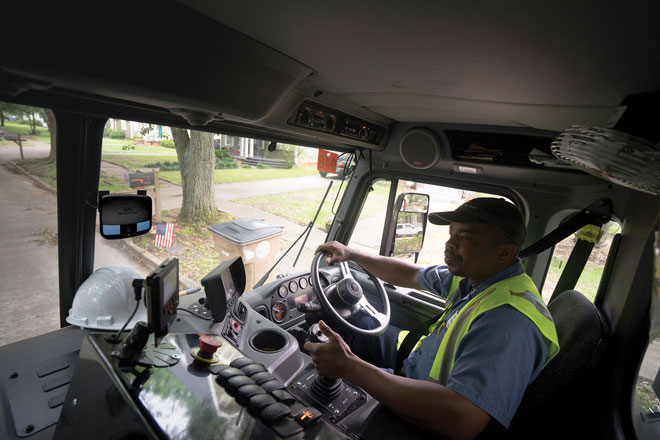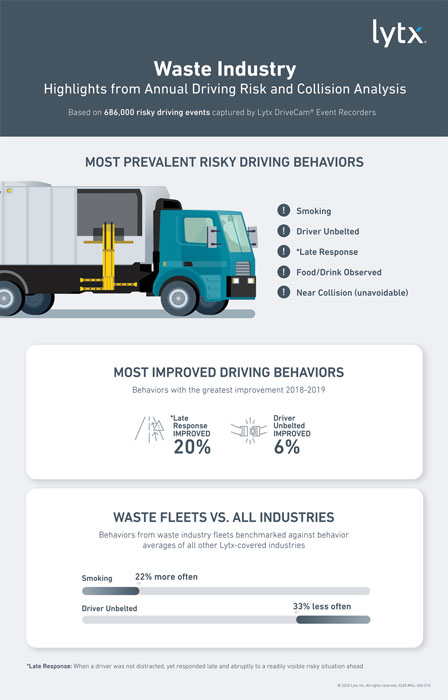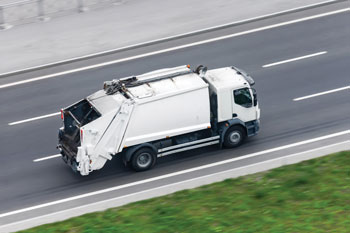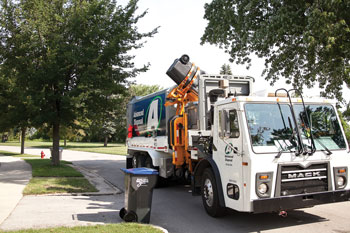These days, when it is difficult to get people in a room and even harder to supervise directly, technology can provide cost-effective ways to help ensure worker safety, prevent accidents and delays, and keep community services running.
By Del Lisk

The solid waste sector has long had to lead the way in new safety technologies and procedures, due to its special circumstances and particular safety concerns. Tight alleys, pedestrians and vehicles present an extremely complex driving environment that makes waste fleet operations especially challenging. Driver behaviors that would be risky elsewhere could be even more dangerous when operating extremely heavy trucks in this complex setting—and small mistakes can have big, costly consequences.
According to the U.S. Bureau of Labor Statistics (BLS), refuse and recyclable material collection remains the fifth most dangerous civilian job, reporting a rate of 44.3 fatal workplace injuries per 100,000 full-time equivalent workers in 2018. The Solid Waste Association of North America (SWANA), reported 44 sanitation worker fatalities in 2019, with more than two-thirds of them during collection operations.
COVID-19 adds a number of challenges that make safety even more important and yet harder to achieve. Sheltering in place has led to dramatic increases in the volume of residential waste while reducing the number of available drivers. Waste haulers may need to turn to less experienced substitute drivers, but these drivers may be prone to increased likelihood of getting into a collision. Although departments are coping by delaying or suspending some services such as yard trimming and bulk item pickup, they may remain understaffed and overstretched. The resulting higher workplace stress and unrelenting demand can lead to distracted and inattentive driving.
Fleet safety has become an even more urgent priority over the last several years due to rapidly rising insurance rates and litigation costs. Underwriters increasingly encourage companies to equip their fleets with telematics and video technology to improve driver safety and provide evidence after the fact in case of an incident. In many cases, video evidence may clear the name of a company whose driver was acting properly, helping to weed out fraudulent or invalid claims. Even when your company is at fault, reliable video recordings can let you know the facts quickly and may help you reduce investigative and legal expenses, making it potentially easier and faster to settle matters.
It is more important than ever to have the evidence to protect fleets against liability and safety risks. In the event of a collision, the other party’s attorney is likely to subpoena cell phone records and review your company’s cell phone policy to determine whether the driver (or your company) might be liable. It is better to know ahead of time whether a driver is engaging in a behavior that might put the company at risk, rather than finding out after a problem develops.
Technology Can Help
It is difficult to maintain direct personal oversight of every driver, especially with social distancing measures in place, but there are technologies that can help. In particular, two technology trends are converging to provide a “sixth sense” that can make you aware of high-risk driving behaviors before they cause problems: machine vision (MV) and artificial intelligence (AI).
MV uses image analysis to detect objects and behaviors from visual data. These systems can identify objects in the environment that might be related to high-risk behavior both inside and outside the vehicle: when drivers are drowsy or distracted by a cell phone, not wearing a seat belt, following too closely, not maintaining lane position or failing to obey a stop sign. These are all potentially dangerous, costly behaviors that often go undetected and end up causing thousands of vehicle fatalities each year. Even seemingly innocuous acts like forgetting to wear a seat belt are correlated with additional risk; drivers cited for seat belt violations are 3.4 times more likely to get into a collision than the average driver.

AI is the capability of a computer to perform reasoning and other behavior in a way that a human might. Solutions based on AI learn better over time by integrating data from multiple sources, improving their algorithms and their precision along the way.

Combined, MV and AI can “see” not just objects, but also associated behaviors, even when the objects are not visible to the camera. For example, the system can detect a driver constantly looking down over a period of time and be confident in making a determination that the driver is looking at a device and deliver an audio alert to prompt the driver to change what they are doing. These technologies can detect multiple risky behaviors occurring at the same time, such as a driver using a cell phone and not wearing a seatbelt. By detecting objects outside the visual frame and recognizing patterns that indicate specific behaviors, MV and AI operate as a second set of formally trained, always-on eyes that help ensure the safety and performance of drivers and their vehicles.
When the system detects and identifies a risky behavior, it sounds an audible alert in the cab. This lets the driver recognize and self-correct the behavior. Over the long term, it helps drivers improve behavior on their own, and can make drivers safer overall.
When you and your drivers can see what is going on behind the wheel, drivers are more empowered to self-correct and those drivers who need a bit of coaching to develop better habits can receive coaching as needed. Coaching risky behavior early helps you reduce collisions and claims costs. Safer driving is also good for business—it means more work completed, fewer vehicles out of commission, and better adherence to company policies. When you identify your risky drivers, you have the video evidence needed to coach them to better habits. And for the majority of your drivers, the ability to view risky events on their own and self-coach is powerful.
The goal is not just to see what happened after the fact, but to detect behavior ahead of time and enhance safety. A video telematics system can decrease collisions and claims costs up to 80 percent. You cannot always be watching, but you can see near real-time data about what is going on, with context that shows the bigger picture. A video telematics solution can reveal if specific drivers or locations are associated with patterns of risk.

Best Practices
The most important factor in waste fleet safety is information. As the saying goes: “you can’t manage what you don’t know.” Being aware of applicable laws, available resources and insight into driver behavior are all important keys to reducing risk. Sharing information transparently, including what the organization’s leadership plans to do about distracted driving, builds trust and helps drivers prepare. An environment of trust and accountability is an essential ingredient in a safer workplace. Here are a few best practices to consider:
- Inform drivers on the risks of distracted driving and the laws in place to address it. Share real life stories about the impacts of distracted driving and tap into online distracted driving resources to assist with efforts to educate your work force.
- Establish clear policies and maintain accountability by reinforcing, monitoring and enforcing them.
- Consider a video telematics solution that provides real-time insight into challenging drivers, locations and circumstances.
- Roll out plans and technology transparently to let drivers know what is in it for them.
- Reward good drivers, using positive feedback and coaching rather than punishment to help drivers improve.
It is especially important to establish policies to help workers communicate safely while driving, ensuring that they are not distracted by cell phones or handheld devices.
Managing Risk
In an industry stretched thin, it can be difficult to stay focused on safety—but managing risk ahead of time is always better than waiting until an incident occurs, and then wishing you had known. These days, when it is difficult to get people in a room and even harder to supervise directly, technology can provide cost-effective ways to help ensure worker safety, prevent accidents and delays, and keep community services running. | WA
Del Lisk is the Vice President of Safety Services for Lytx Inc. (San Diego, CA). As a fleet safety expert, Del speaks at major conferences including National Safety Council (NSC) Congress & Exposition, American Society of Safety Engineers (ASSE) Annual Convention, Public Risk Management Association (PRIMA) and Risk Management Insurance Society (RIMS) conferences and meetings. For more information, call (866) 419-5861 or visit www.lytx.com.
